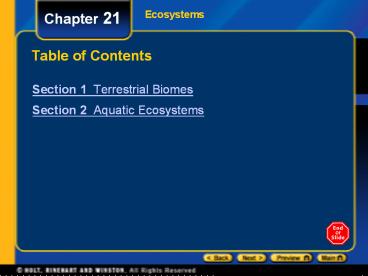Table of Contents - PowerPoint PPT Presentation
1 / 26
Title: Table of Contents
1
Table of Contents
Ecosystems
Chapter 21
- Section 1 Terrestrial Biomes
- Section 2 Aquatic Ecosystems
2
Objectives
Section 1 Terrestrial Biomes
Chapter 21
- Identify the eight major biomes.
- Compare tundra with taiga.
- Compare the different kinds of forests.
- Compare the different kinds of grasslands.
- Describe the adaptations of desert organisms.
3
The Major Biomes
Section 1 Terrestrial Biomes
Chapter 21
- The major types of terrestrial ecosystems, known
as biomes, are tundra, tropical forest, temperate
forest, taiga, temperate grassland, savanna,
chaparral, and desert.
4
Earths Major Biomes
Section 1 Terrestrial Biomes
Chapter 21
5
Tundra
Section 1 Terrestrial Biomes
Chapter 21
- Tundra is a cold biome characterized by
permafrost under the surface of the ground.
6
Forests
Section 1 Terrestrial Biomes
Chapter 21
- Tropical Forests
- Tropical forests receive abundant rainfall and
have stable temperatures. - They have a greater species richness than any
other biome.
7
Forests, continued
Section 1 Terrestrial Biomes
Chapter 21
- Temperate Forests
- Temperate forests have coniferous trees, which
bear seeds in cones, or deciduous trees, which
shed their leaves each year.
8
Forests, continued
Section 1 Terrestrial Biomes
Chapter 21
- Temperate Deciduous Forests
- The trees in temperate deciduous forests shed all
of their leaves in the fall.
9
Forests, continued
Section 1 Terrestrial Biomes
Chapter 21
- Taiga
- Taiga is cold but is warmer than tundra and
receives more precipitation. - Taiga is dominated by coniferous forests.
10
Grasslands
Section 1 Terrestrial Biomes
Chapter 21
- Temperate Grasslands
- Temperate grasslands occur in areas with cold
winters and hot summers. - They are dominated by grasses and herds of
grazing animals.
11
Grasslands, continued
Section 1 Terrestrial Biomes
Chapter 21
- Savanna
- Savannas are tropical grasslands with alternating
wet and dry seasons. - They are dominated by herds of grazing animals.
12
Grasslands, continued
Section 1 Terrestrial Biomes
Chapter 21
- Chaparral
- Chaparral is found in coastal regions with warm,
dry summers and mild winters. - It is dominated by dense, spiny shrubs.
13
Deserts
Section 1 Terrestrial Biomes
Chapter 21
- Deserts receive less than 25 cm (9.9 in.) of
precipitation per year. - Desert inhabitants have adaptations for
conserving water.
14
Objectives
Section 2 Aquatic Ecosystems
Chapter 21
- Identify the major ocean zones.
- Compare the aphotic zone with the photic zone.
- Compare the neritic zone with the oceanic zone.
- Describe estuaries.
- Compare eutrophic lakes with oligotrophic lakes.
- Explain the significance of gradient in rivers
and streams. - Describe freshwater wetlands.
15
Ocean Zones
Section 2 Aquatic Ecosystems
Chapter 21
- The photic zone in the ocean receives light, but
the aphotic zone does not. - Other zones of the ocean are defined based on
their relative locations.
16
Ocean Zones, continued
Section 2 Aquatic Ecosystems
Chapter 21
- The Intertidal Zone
- In the intertidal zone, organisms must be able to
tolerate drying and pounding by waves.
17
Intertidal Zone
Section 2 Aquatic Ecosystems
Chapter 21
18
Ocean Zones, continued
Section 2 Aquatic Ecosystems
Chapter 21
- The Neritic Zone
- The neritic zone receives nutrients from the
bottom of the ocean and from land. It is the
oceans richest zone in terms of the number of
species and individuals.
19
Neritic Zone
Section 2 Aquatic Ecosystems
Chapter 21
20
Ocean Zones, continued
Section 2 Aquatic Ecosystems
Chapter 21
- The Oceanic Zone
- Production in the oceanic zone is limited by a
shortage of nutrients.
21
Ocean Zones, continued
Section 2 Aquatic Ecosystems
Chapter 21
- Estuaries
- Estuaries are very productive areas where rivers
and streams flow into the sea.
22
Freshwater Zones
Section 2 Aquatic Ecosystems
Chapter 21
- Lakes and Ponds
- Oligotrophic lakes are clear and lacking in
nutrients. - Eutrophic lakes are rich in nutrients and are
often murky.
23
Three Lake Zones
Section 2 Aquatic Ecosystems
Chapter 21
24
Freshwater Zones, continued
Section 2 Aquatic Ecosystems
Chapter 21
- Rivers and Streams
- Rivers and streams are bodies of water that flow
down an elevation gradient within a watershed.
25
Freshwater Zones, continued
Section 2 Aquatic Ecosystems
Chapter 21
- Freshwater Wetlands
- Freshwater wetlands are areas of land, such as
marshes and swamps, that are covered with fresh
water for at least part of each year.
26
Freshwater Biomes
Section 2 Aquatic Ecosystems
Chapter 21

